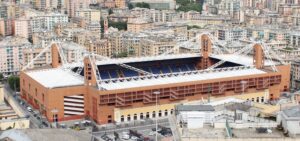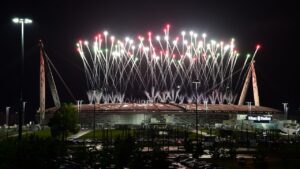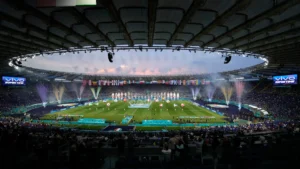Stadiums of the 2025/26 Serie A Season
The 2025/26 Serie A season, starting on August 23, 2025, promises passionate Italian football across 20 historic and modern stadiums. With Sassuolo, Pisa, and Cremonese promoted to replace relegated Empoli, Venezia, and Monza, the league mixes established giants with ambitious returnees. This blog lists all 18 Bundesliga stadiums, spotlights the oldest, newest, and most iconic venues, explores the promoted teams’ grounds with key historical moments, and shares intriguing details on these arenas that embody Serie A’s spirit.
All 20 Serie A Stadiums for 2025/26
Here’s a table of the teams and their home stadiums for the 2025/26 season, with approximate capacities and locations based on current data.
|
Team
|
Stadium
|
Capacity
|
Location
|
|---|---|---|---|
|
Atalanta
|
Gewiss Stadium
|
24,950
|
Bergamo
|
|
Bologna
|
Stadio Renato Dall’Ara
|
38,279
|
Bologna
|
|
Cagliari
|
Unipol Domus
|
16,416
|
Cagliari
|
|
Como
|
Stadio Giuseppe Sinigaglia
|
13,602
|
Como
|
|
Cremonese
|
Stadio Giovanni Zini
|
20,641
|
Cremona
|
|
Fiorentina
|
Stadio Artemio Franchi
|
43,118
|
Florence
|
|
Genoa
|
Stadio Luigi Ferraris
|
33,205
|
Genoa
|
|
Hellas Verona
|
Stadio Marcantonio Bentegodi
|
31,713
|
Verona
|
|
Inter Milan
|
San Siro
|
75,710
|
Milan
|
|
Juventus
|
Juventus Stadium
|
41,507
|
Turin
|
|
Lazio
|
Stadio Olimpico
|
67,585
|
Rome
|
|
Lecce
|
Stadio Via del Mare
|
30,354
|
Lecce
|
|
AC Milan
|
San Siro
|
75,710
|
Milan
|
|
Napoli
|
Stadio Diego Armando Maradona
|
54,732
|
Naples
|
|
Parma
|
Stadio Ennio Tardini
|
22,352
|
Parma
|
|
Pisa
|
Arena Garibaldi – Stadio Romeo Anconetani
|
12,508
|
Pisa
|
|
Roma
|
Stadio Olimpico
|
67,585
|
Rome
|
|
Sassuolo
|
Mapei Stadium – Città del Tricolore
|
21,515
|
Sassuolo
|
|
Torino
|
Stadio Olimpico Grande Torino
|
28,177
|
Turin
|
|
Udinese
|
Stadio Friuli
|
25,132
|
Udine
|
Averaging around 37,000 capacity, these stadiums showcase Serie A’s rich heritage, with Lombardy and Tuscany as prominent regions.
The Oldest Stadium: Stadio Luigi Ferraris (Genoa)
 Established: 1911
Established: 1911- Details: Stadio Luigi Ferraris, home to Genoa, is the Serie A’s oldest stadium for 2025/26, with a 33,205 capacity. Shared with Sampdoria, its compact design and red-brick architecture create a fervent atmosphere in the historic Marassi district.
- Historical Moment: On June 11, 1990, during the World Cup, the stadium hosted Costa Rica’s stunning 1-0 upset over Scotland, a shock result that highlighted its role on the global stage and the electric energy of Italian crowds.
- Fascinating Fact: As Italy’s oldest stadium still in use for top-flight football, its iconic towers and location inside a former racecourse add a unique layer of history, with renovations preserving its early 20th-century charm.
The Newest Stadium: Juventus Stadium (Juventus)
 Established: 2011
Established: 2011- Details: Juventus Stadium, Juventus’s 41,507-capacity home, is Serie A’s newest venue, built on the site of the old Stadio delle Alpi. Its modern, track-free design ensures excellent sightlines and an intense atmosphere for the Bianconeri faithful.
- Historical Moment: On September 11, 2011, the stadium’s first official match saw Juventus thrash Parma 4-1, marking a new era for the club and symbolizing their resurgence after the Calciopoli scandal.
- Fascinating Fact: The first Italian stadium owned outright by a club, it features innovative safety and sustainability elements, setting a benchmark for modern football arenas in Italy.
The Most Iconic Stadium: San Siro (Inter Milan and AC Milan)
 Established: 1926
Established: 1926- Details: San Siro, shared by Inter Milan and AC Milan with a 75,710 capacity, is Serie A’s most iconic stadium, known for its towering structure and legendary derbies. A symbol of Milanese football, it draws global fans for its grandeur.
- Historical Moment: On June 8, 1990, the stadium hosted the World Cup opening match where Cameroon shocked defending champions Argentina 1-0, an iconic upset that captured the world’s attention and showcased San Siro’s dramatic flair.
- Fascinating Fact: Its distinctive cylindrical towers and external spiral ramps are architectural marvels, and it has hosted four European Cup finals, making it a cornerstone of football history.
Spotlight on Promoted Teams’ Stadiums
Sassuolo’s Mapei Stadium – Città del Tricolore, opened in 1995 with a 21,515 capacity, is a modern multi-purpose venue in Reggio Emilia, known for its excellent facilities despite being outside Sassuolo. On August 25, 2013, it hosted Sassuolo’s Serie A debut, a 1-1 draw with Napoli that announced their arrival in the top flight. Owned by sponsor Mapei, the stadium’s acquisition in 2013 was pivotal for the club’s stability, blending corporate backing with local pride. Pisa’s Arena Garibaldi – Stadio Romeo Anconetani, established in 1919 and holding 12,508 fans, is a historic gem near the Leaning Tower, recently renovated for Serie A. The “Curva Nord” generates intense support, preserving its old-school charm. On June 13, 1982, Pisa clinched promotion to Serie A with a 1-0 win over Bari, sparking wild celebrations under legendary president Romeo Anconetani. Its scenic location and Etruscan archaeological finds during upgrades add a unique cultural dimension. Cremonese’s Stadio Giovanni Zini, opened in 1919 with a 20,641 capacity, is a renovated classic named after a WWI-fallen goalkeeper. The “Curva Sud” drives the passionate Grigiorossi fans, mixing history with modern touches. In 1925, the stadium was officially named after Giovanni Zini, honoring the club’s first keeper who perished in war, a moving tribute that defines its emotional core. Discoveries of an Etruscan necropolis in 1991 during works highlight its ancient roots beneath the pitch.
Additional Stadium Highlights
 Stadio Olimpico (Lazio and Roma), opened in 1953, hosted the 1990 World Cup final and glows with Roman history, its 67,585 seats echoing ancient gladiatorial spirit. Stadio Diego Armando Maradona (Napoli), renamed in 2020, features murals of the legend and hosted Argentina’s 1990 World Cup semi-win, with 54,732 passionate Partenopei fans.
Stadio Olimpico (Lazio and Roma), opened in 1953, hosted the 1990 World Cup final and glows with Roman history, its 67,585 seats echoing ancient gladiatorial spirit. Stadio Diego Armando Maradona (Napoli), renamed in 2020, features murals of the legend and hosted Argentina’s 1990 World Cup semi-win, with 54,732 passionate Partenopei fans.
Stadio Artemio Franchi (Fiorentina), from 1931, boasts Art Deco curves and hosted the 1990 World Cup, its 43,118 capacity amplifying Viola ultras’ fervor. Stadio Renato Dall’Ara (Bologna), dating to 1927, integrates a medieval tower and was renovated for the 1990 World Cup, creating a unique blend of history and intimacy.
From the 114-year legacy of Stadio Luigi Ferraris to the state-of-the-art Juventus Stadium, the 2025/26 Serie A’s venues weave together tradition and innovation. San Siro’s legendary aura, Mapei Stadium’s modern rise, and Arena Garibaldi’s scenic passion promise unforgettable moments. Which stadium’s story calls to you? Get your tickets from here and immerse yourself in the electric atmosphere, becoming part of the thrilling matches that define Serie A!

